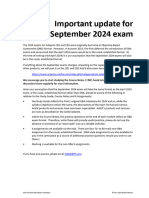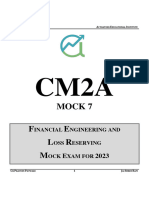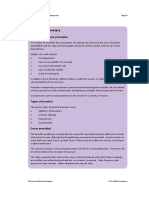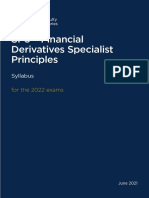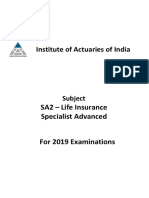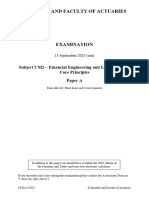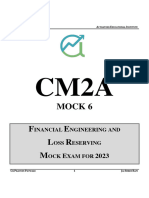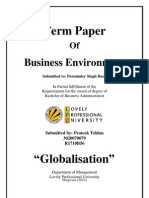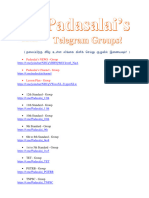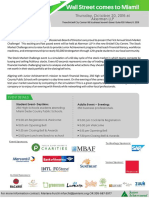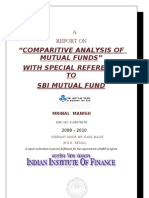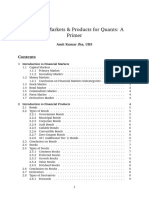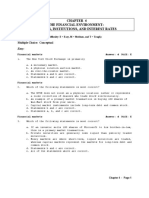CB1 FormulaSheet
Uploaded by
farha mubarakCB1 FormulaSheet
Uploaded by
farha mubarakACTEX Learning
Exam CB1 Formula & Review Sheet
(updated 06/21/2024)
FINANCE AND CORPORATE GOVERNANCE
The Financial Reports are used to help all stakeholders of an organisation in the decision-making
process.
The International Accounting is a body that develops, issues, and withdraws accounting standards.
Standards Board (IASB) The standards that are issued by the IASB are currently called International
Financial Reporting Standards (IFRSs).
International Financial These are a set of high-quality global standards with an objective of harmon-
Reporting Standards (IFRS) ising standards for international accounting.
The Financial Reporting It is a body in the UK whose objective is to ensure high standards of report-
Council (FRC) ing and audit to promote investor confidence, enable the capital markets to
operate efficiently and therefore to help drive economic growth.
Corporate Governance Its purpose is to facilitate effective, entrepreneurial and prudent management
that can deliver the long-term success of the company.
The main principles of the UK • Board Leadership and Company Purpose
Corporate Governance Code are: • Division of Responsibilities
• Composition, Succession and Evaluation
• Audit, Risk and Internal Control
• Remuneration.
Financial Decisions Finance involves two basic issues: Investment Decisions; and Financing Deci-
sions.
Investment Decision It is the decision of investing or not in real assets in order to create value.
(Capital Budgeting Decision)
Financing Decision It is the decision of choosing the best combination of different sources of funds
to finance investment and the operations.
Capital Markets refer to the financial markets where companies can raise funds by issuing
various types of securities to investors. For large, publicly quoted companies,
the stock market serves as a performance monitor.
Key effects of the capital markets • Sound investment decisions require accurate measurement of the cost of
on a firm’s decisions include: capital.
• Limitations in the supply of capital focus attention on methods of raising
finance.
• Mergers and takeovers create threats and opportunities to be exploited.
• ‘Externalities’ require managers to determine the appropriate role of or-
ganisation.
Agency Theory refers to the relationship between a principal (Shareholder) and an agent of
that principal (Directors/Top Management), namely to situations when the
former do not act in the best behalf of the former. It includes issues such as
the nature of the agency costs, conflicts of interest (and how to avoid them)
and how agents may be motivated and incentivised.
Agency Problem refers to a conflict of interest that may arise when the interest of the principal
(Principal-Agent Problem) (shareholder) is not aligned with those of the agent (manager).
Copyright © ArchiMedia Advantage Inc.
www.ACTEXLearning.com Need Help? Email support@actexlearning.com All Rights Reserved
ACTEX Learning Exam CB1 Formula & Review Sheet 2
Agency Costs refers to the expenses/costs that arise when there is a conflict of interest
between shareholders and management in a context of separation between
the ownership and control of the company.
Conflicts of Interest arises because the agent (managers) may be motivated by objectives which
are at variance with the desires and interests of the principals (shareholders).
Information Asymmetries often exist between the various classes of stakeholder because all parties do
not share the same insights into the fortunes of the company. More commonly
referred about shareholders and management.
Value of an Asset Present value of its expected cash flows/returns.
Future Cash Flow(CF)n
Present Value of Cash Flows =
(1 + r)n
( )1
Future Cash Flow n
Discount Rate (r) = −1
PV
Economic Value Added (EVA) = Net Operating Profit After Taxes
− (Invested Capital × Weighted Average Cost of Capital)
Dimensions of Ethical • Responsibilities of Principals and Agents.
Considerations in Finance and • Environmental and Social Governance Goals(ESG).
Corporate Governance: • Personal and Professional Responsibility.
COMPANY OWNERSHIP
The following are types of • Sole Trader.
Business Entities: • Partnership.
• Limited Companies.
• Limited Liability Partnerships
• Social Enterprises.
Sole Trader is a business which is owned by one person and which is not a limited company.
Sole traders have unlimited legal liability for their business debts.
Partnership is a business which is owned by more than one person and is not a limited
company. The owners have unlimited liability.
Limited Company is a business which has a legal identity separate from the owners of the busi-
ness. The owners of the company are called shareholders. The owners’ liability
is limited to the fully paid value of their shares.
A Limited Liability is a new corporate identity, which was introduced in the UK in 2001. This is
Partnership (LLP) a business vehicle that gives the benefits of limited liability whilst retaining
other characteristics of a traditional business partnership.
A Public Limited Company is a company whose documentation states that it is a public company and
which has an issued share capital of at least £50,000. The name of a public
limited company must end with the words ‘public limited company’ (or the
abbreviation PLC or plc). Only PLC can be listed in a stock exchange.
A Private Limited Company All limited companies that are not Public Limites Company. A Private Lim-
ited Company or just Private Company is not allowed to offer its shares to
the public and its name must end with the word ‘limited’ (or the abbreviation
LTD or ltd).
A Social Enterprise is a business entity which has a clear social or environmental mission. This
might be, for example, to provide low-cost loans to small farmers in poor coun-
tries, provide low-cost private schools or support vaccination programmes.
Copyright © ArchiMedia Advantage Inc.
www.ACTEXLearning.com Need Help? Email support@actexlearning.com All Rights Reserved
ACTEX Learning Exam CB1 Formula & Review Sheet 3
The types of Long-Term Capital • Loan capital (‘Debt’): money borrowed from creditors. In exchange, the
of a business are: firm pays interest and an eventual return on capital.
• Ordinary shares (‘Equities’): Represent a fraction of the equity of the
firm. Shareholders are the owners of the firm and are entitled with voting
rights and a share part of the company’s profits.
The types of Medium-Term • Credit sale: A credit sale is a normal sale of a good together with an
Company Finance of a business agreement that payment will be made by a series of regular instalments
are: over a set period.
• Leasing: A lease is an agreement where the owner of an asset gives the
lessee the right to use the asset over a period, in return for a regular series
of payments.
• Bank loans: bank loan is a form of medium-term borrowing from a bank
where the full amount of the loan is paid into the borrower’s current ac-
count and the borrower undertakes to make interest payments and capi-
tal.repayments on the full amount of the loan
• Private equity funds: Investment funds that invest in private companies,
instead of public companies.
The types of Short-Term • Bank overdrafts: An overdraft is a form of short-term borrowing from
Company Finance of a business a bank where the borrower is granted a facility to draw money out of a
entity are as follows: current account such that it becomes negative, down to an agreed limit.
• Trade credit: Agreement between a company and one of its suppliers to
pay for goods or services after they have been supplied.
• Factoring: Non-recourse factoring is where the supplier sells on its trade
debts to a factor in order to obtain cash payment of the accounts before
their actual due date. Recourse factoring only provides early payment of
invoices.
• Bills of exchange: A bill of exchange is effectively a claim to the amount
owed by a purchaser of goods on credit and may be ‘accepted’ by a bank
(for a fee).
• Commercial paper. Single name form of short-term borrowing (short-
term bonds) used by large companies.
Alternative methods of raising • Shadow banking: Shadow banks are non-bank financial institutions that
finance outside the regular engage in unregulated banking activities by borrowing short-term funds in
banking system include the the money market and investing them long-term..
following: • Project financing: Project financing is commonly employed for large
infrastructure projects. It relies on non-recourse funding involving a con-
sortium of lenders from both the host country and abroad..
• Peer-to-peer lending: Loans available on peer-to-peer lending platforms.
• Crowdfunding The practice of funding a project or venture by raising
money from a large number of people who each contribute a relatively
small amount, typically via the internet.
• Microfinance: are small loans that are usually easier and faster to secure
than the traditional loans. No interest is paid on the loan and the investor
has the benefit of being involved in initiating a venture.
Copyright © ArchiMedia Advantage Inc.
www.ACTEXLearning.com Need Help? Email support@actexlearning.com All Rights Reserved
ACTEX Learning Exam CB1 Formula & Review Sheet 4
TAXATION
Personal Income Tax = Taxable Income × Applicable Personal Tax Rate
Capital Gains Tax = Capital Gain × Capital Gains Tax Rate
Chargeable Gain = Selling Price − Purchase Price − Allowable Deductions
Company Taxation refers to the process of imposing taxes on the profits and income earned by
businesses or corporations.
Corporate Taxable Profits = Income − Allowable Expenses + Capital Gains.
Corporate Income Tax = Corporate Taxable Profits × Applicable Corporate Tax Rate
Offshore Investments Funds refers to investment funds that are established in jurisdictions outside of an
individual’s home country. Differences between tax systems can make inter-
national investment complex and may lead investors to pay more tax than is
intended within the jurisdiction in which they live.
Double Taxation Relief (DTR) means that the local tax authority will allow companies and individuals with
overseas income or capital gains to offset tax paid overseas against their lia-
bility to domestic tax on that income or capital gains. “The maximum offset
is the rate of tax that would have been paid locally.”
Other taxes In addition to income taxes, taxation systems also include VAT, custom du-
ties, Stamp duty, Inheritance taxes and property taxes among others.
FINANCIAL INSTRUMENTS
Debentures are loans which are secured on some or all assets of the company. This means
that, if the company fails to make one of the coupon payments or the capital
repayment, various actions are available to the stock holders.There are two
types of debenture: Mortgage debenture (fixed charge) and Floating charge
debenture.
Fixed Charge Debenture A fixed charge means that there are specific secured assets mentioned in the
legal documentation for the mortgage debenture.
Floating Charge Debenture The company can change the secured assets in the normal course of business.
When a company fails to make an interest or capital payment, the debenture
holders can apply to the courts to convert the floating charge to a fixed charge.
Unsecured Loan Stock Here there is no specific security for the loan. If the company defaults, the
loan stock holders’ only remedy is to sue the company. To compensate for
the additional risk, the Gross Redemption Yield will be higher.
Gross Redemption Yield The Gross Redemption Yield or Yield to Maturity is the annual return if the
loan stock is hold until maturity and there are no default event.
Eurobonds are a particular category of international debt security that are issued in a
currency other than the currency of the country or countries where the bond
is issued. Despite their name, Eurobonds can be issued in a variety of other
currencies and not only euros.
Equity capital refers to the total amount of capital that a company raises by issuing and sell-
ing its shares of stock to investors or shareholders. It represents the ownership
stake or ownership interest that shareholders hold in the company.
Copyright © ArchiMedia Advantage Inc.
www.ACTEXLearning.com Need Help? Email support@actexlearning.com All Rights Reserved
ACTEX Learning Exam CB1 Formula & Review Sheet 5
Deferred shares Shares with no right to dividends until certain conditions are met or only
after a set period. Deferred shares often have limited capital rights and no
right to vote.
Redeemable Ordinary Shares “Redeemable Ordinary Shares” refer to a type of company shares that carry
the feature of being redeemable by the issuing company at a predetermined
future date or under specific conditions. These shares are considered a hybrid
between ordinary (common) shares and debt instruments.
Non-Voting Shares is a class of ownership interest in a company that do not have the right to
vote on specific corporate matters at shareholder’s meetings.
Shares with Multiple are a type of equity ownership in a company that gives their owners more
Voting Rights voting power than those of ordinary or common shares.
Golden Share is often used to describe a special class of shares that give their bearer unique
and important rights, frequently within a company, in addition to the regular
rights attached to common shares.
Preference Shares a class of shares in a company that entitles the holders to receive certain
preferential rights and privileges over ordinary (common) shareholders. These
rights often include a fixed dividend payment and priority in receiving assets
in the event of liquidation. Typically, preference shares do not have voting
rights.
Convertible Unsecured are unsecured loan stocks which give the right to convert into ordinary shares
Loan Stocks of the company at a later date. The investor does not pay anything to convert
other than surrendering the convertible preference shares.
Convertible Preference Shares are preference shares which give the right to convert into ordinary shares
at a later date. The investor does not pay anything to convert other than
surrendering the convertible preference shares.
Rest Period is the period prior to the first possible date for conversion of preference shares.
Conversion Premium is the difference between the cost of obtaining one ordinary share by purchas-
ing the required number of convertible securities and the market price of the
share.
Contingent Convertibles are loan stocks that convert into ordinary shares of the issuing company once
a specified trigger is reached.
Floating rate notes (FRNs) are medium-term debt securities issued in the Euro market whose interest
payments ‘float’ with short-term interest rates, possibly with a stipulated
minimum rate.
Subordinated Debt Debt that ranks below the firm’s general creditors (but ahead of preference
shareholders and the ordinary shareholders). The subordinated lender holds
a junior debt and is paid after all senior debt holders are satisfied.
Junior Debt is a type of debt that ranks lower in priority for repayment compared to
other forms of debt issued by a company. It is called “junior” because it is
subordinate to senior debt in the hierarchy of debt repayment.
Senior Debt is a type of debt that holds the highest priority for repayment in the event of
a company’s financial distress, liquidation, or bankruptcy. It is called “senior”
because it is at the top of the hierarchy of debt repayment.
Asset-backed securities (ABSs) are securities backed by ring-fenced pools of assets (which are held in trusts).
Investors are repaid through interest and capital payments made from the
pools of assets.
Copyright © ArchiMedia Advantage Inc.
www.ACTEXLearning.com Need Help? Email support@actexlearning.com All Rights Reserved
ACTEX Learning Exam CB1 Formula & Review Sheet 6
Mortgage-Backed Securities refers to assets-backed securities (ABSs) which may be backed by mortgages.
Collateralised Debt are a form of Asset-Backed Securities. A CDO works by pooling together a
Obligations (CDOs) variety of assets and then repackaging them into different tranches of securities
with varying levels of risk and return.
Covered Bonds are bonds issued by banks or building societies with ring-fenced pools of assets
that will repay investors if the issuing institutions fail.
Executive Stock Options are options issued by a company on its own shares and issued to senior man-
agers as part of their remuneration package, with strike prices that are in-
tended to represent a performance target for the executive.
Futures Contract is a standardised, exchange tradable contract between two parties to trade a
specified asset on a set date in the future at a specified price.
Bond Futures are financial contracts that require both the buyer and seller to deliver a
quantity of a certain bond at predetermined price and date in the future. For
delivery, the contract requires physical delivery of a bond. If the contract is
specified in terms of a notional stock, then there needs to be a linkage between
it and the cash market.
Short Interest Rate Futures Short interest rate futures are standardized agreements to buy or sell a short-
term interest rate instrument at a predetermined future date and at a price
agreed upon today.
Stock Index Futures Stock Index Futures allow traders and investors to speculate on or hedge
against movements in the overall stock market without directly buying or
selling the underlying stocks..
Currency Futures are financial contracts that obligate the buyer to purchase and the seller to de-
liver, a specific quantity of a particular currency at a predetermined exchange
rate on a specified future date.
Forwards are non-standard contracts traded in the Over-the-Counter Market to buy
or sell an asset on an agreed basis in the future. Unlike futures contracts,
forward contracts are not standardised contracts and cannot be traded in a
recognised exchange.
Uses of Financial Futures Future and Forwards contracts can be used to lock future selling and buying
prices of different asset classes.
An option gives an investor with a long position the right, but not the obligation, to
buy or sell a specified asset on a specified future date. The writer has the
corresponding obligation.
Call Option The buyer of the option has the right, but not the obligation, to buy a specified
asset on a set date in the future for a specified price. The respective seller
has the obligation to sell
Put Option The buyer of the option has the right, but not the obligation, to sell a specified
asset on a set date in the future for a specified price. The respective seller
has the obligation to buy.
An American Style Option is an option that can be exercised on any date before until its expiry.
An European Style Option is an option that can be exercised only at its expiry.
Uses of Options Options allow a company to protect itself against adverse movements in the
financial environment while retaining the ability to profit from favourable
movements.
Copyright © ArchiMedia Advantage Inc.
www.ACTEXLearning.com Need Help? Email support@actexlearning.com All Rights Reserved
ACTEX Learning Exam CB1 Formula & Review Sheet 7
A Swap is a contract between two parties under which they agree to exchange a series
of payments according to a prearranged formula.
Interest Rate Swap Here one party agrees to pay to the other a regular series of fixed amounts
for a certain term. In exchange, the second party agrees to pay a series of
variable amounts based on the level of a short-term interest rate.
A Currency Swap is an agreement to exchange a fixed series of interest payments and a capital
sum in one currency for a fixed series of interest payments and a capital sum
in another currency.
The following are uses of swaps: • Risk management: A company can use swaps to reduce risk by matching
its assets and liabilities.
• Reducing the cost of debt: Companies can use an interest rate swap to
reduce the total cost of financing, such that both benefit from a lower cost
of debt.
FINANCIAL INSTRUMENTS - BOND VALUATION
( ) T1
Face Value
Yield to Maturity (Y T MT ) = −1
p0
CP N CP N CP N + FV
Price of a Bond Today (P0 ) = + + ... +
1 + YTM1 (1 + YTM2 )2 (1 + YTMT )T
Where:
T - Term to maturity
CPN - Coupon Payment
FV - Face Value
FINANCIAL INSTRUMENTS - STOCK VALUATION
DIV1 + P1 − P0
Cost of Equity (rE ) =
P0
Div1
Stock Price (P0 ) =
rE − g
DIV
Plowback Ratio = 1 − Payout Ratio = 1 −
EPS
Earnings growth rate (g) = Plowback Ratio × ROE
F CF1 F CF2 F CFH P VH
Stock Price (P0 ) = + 2
+ ... + H
+
1 + rE (1 + rE ) (1 + rE ) (1 + rE )H
DIV1 DIV2 DIVT PT
Stock Price (P0 ) = + + ... + +
1 + rE (1 + rE )2 (1 + rE )T (1 + rE )T
Div1
Cost of Equity (rE ) = +g
P0
Where:
DIV - Dividend per share
T - Time
FCF - Free Cash Flow to the Firm
ROE - Return on Equity
Copyright © ArchiMedia Advantage Inc.
www.ACTEXLearning.com Need Help? Email support@actexlearning.com All Rights Reserved
ACTEX Learning Exam CB1 Formula & Review Sheet 8
ISSUES OF SECURITIES
Stock Exchange Quotation If a company successfully obtains a quotation on a Stock Exchange, the price
of its securities will be included on the exchange’s official list.
Quoted Securities refers to financial instruments such as stocks that are traded on an exchange
market (stock exchange market in the case of stock).
Listed Securities are securities which are quoted and their price included on the stock ex-
change’s official list.
The reasons for seeking a • To raise capital for the company.
quotation are as follows: • To make it easier for the company to raise further capital.
• To give existing shareholders an exit route.
• To make the shares more marketable and easy to value.
The Disadvantages of • Restricted access to funds as: Cannot sell shares to the public and Lenders
Remaining a Private Company: cannot rely on the company satisfying the requirements of a stock exchange.
• A limited market for shares and so a limited exit route for shareholders,
low liquidity and high transactions costs.
• Shares are not easy to value.
The advantages of remaining • Shares are likely to remain with a small group of shareholders who retain
or becoming a private company control of the company.
are: • A less diverse group of owners means that principal–agent problems are
reduced and thus the company can be managed more effectively to meet
the objectives of shareholders.
• Fewer rules and regulations mean less onerous disclosure and reporting
requirements.
• When companies are owned by families, trusts, and so on, there may be
reasons why the owners prefer not to give control to outside parties.
Issuing Shares Issuing shares refers to the process by which a company issues and sells its
shares or stocks to investors in the primary market. Trading shares is the
activity of buying and selling shares of publicly traded companies on the
secondary market.
Offer for Sale (at a fixed price) In an offer for sale at a fixed price a predetermined number of shares (or other
securities) is offered to the general public at a specified price. Rather than
selling shares directly to the public, the company or existing shareholders sell
the shares to an issuing house.
An Offer for Sale by Tender In this method, the issuing house invites members of the public to submit a
tender stating the number of shares which they are prepared to buy, and the
price which they are prepared to pay.
Offer for Subscription These are similar to offers for sale. They are normally at a fixed price, but can
be by tender. However, the whole issue is not underwritten. The company
sells shares directly to the public.
Placings This is a simpler, cheaper method of making small issues. The issuing house
first buys the securities from the company. It will then individually approach
institutional investors such as pension funds and life offices directly.
Introductions do not involve the sale of any shares. They simply mean that the existing
shares will in future be quoted on the London Stock Exchange.
Copyright © ArchiMedia Advantage Inc.
www.ACTEXLearning.com Need Help? Email support@actexlearning.com All Rights Reserved
ACTEX Learning Exam CB1 Formula & Review Sheet 9
Underwriting is a form of insurance against the risk of an unsuccessful issue. Underwriting
is always used for an offer for sale although it may also be used for other share
issues.
Fully Subscribed Issue Here the issue goes ahead, and is fully subscribed. The issuing house and
the sub-underwriters will have made an underwriting profit equal to their
underwriting commission less any administrative expenses.
Partly Subscribed Issue Here the issue goes ahead, but not all of the shares are purchased. The
underwriters and sub-underwriters get their fee/commission, but they also
need to pay for all the shares that have not been purchased.
A Rights Issue is where a company already quoted offers further shares, at a given price, to
existing shareholders in proportion to their existing holdings.
The main effects of a • New shares are created.
successful rights issue are: • New money is raised for the company.
• The total value of the whole company should be increased by the extra
money raised.
• The price per share will fall depending on the extent of the discount and
the number of new shares issued.
Market Capitalization = P (Price per Share) × Number of Shares
Market Capitalisation
Price Per Share =
Number of Shares
Original Market Capitalisation + Extra Value
Price Per Share after =
Total New Number of Shares
a Rights Issue
Issuing and Trading Shares • Public Companies: Once the shares have been issued, shareholders are
free to trade their shares between themselves, through the markets and
stock exchanges on which the shares are listed and traded.
• Private Companies: Shares can be issued and sold directly only to se-
lected investors. These shares can be very illiquid, as buyers and sellers
have to find each other outside of a designated market place
CAPITAL STRUCTURE AND DIVIDEND POLICY
The components of the capital • Equity capital
of a limited company are: • Short- and medium-term debt
• Long-term debt
Assets of a business can • Non-current assets such as land, property, plant, equipment and ‘intangi-
be divided into: bles’.
• Current assets such as inventories, work-in-progress, debtor balances, cash
(and equivalents).
Non-Current Assets Assets of the entity which:
• it does not expect to realise, or intend to sell or consume, in its normal
operating cycle;
• it does not hold primarily for the purpose of trading;
• it does not expect to realise within 12 months after the reporting;
• are cash or cash equivalents restricted from being exchanged or used to
settle a liability for at least 12 months after the reporting period.
Current Assets Assets of an entity which are not non-current assets.
Copyright © ArchiMedia Advantage Inc.
www.ACTEXLearning.com Need Help? Email support@actexlearning.com All Rights Reserved
ACTEX Learning Exam CB1 Formula & Review Sheet 10
Degree of Acceptable Gearing The extent to which a firm’s investments and operations can be funded by
lenders versus shareholders, without compromissing its value.
Debt
Gearing Ratio Gearing Ratio (as in Core Reading) =
Equity
A Leveraged Firm is a company or firm that also relies on debt or borrowed capital to finance
its operations, investments, and growth.
Market and Capital Structure The stock market will consider every aspect of a company in making the
assessment of worth that culminates in a share price. If the market considers
the capital structure inappropriate or does not appear consistent with the
other features of the firm, the price will change to take that into account.
Taxation and Capital Structure The main features of taxation regarding the capital structure are:
• Interest payments are tax deductible.
• Capital allowances on new plant and equipment are deductible.
• Lease of plant and equipment receives tax relief.
• Property rental payments are tax deductible.
Dividends refers to the periodic payments made by a company to its shareholders, typi-
cally in the form of cash or additional shares of stock as a distribution of the
company’s profits or earnings.
Fundamentals of dividend policy Dividends can be seen as a financing decision – money paid out by way of
dividend is no longer available for investment in the business and changes the
gearing ratio. This is particularly relevant for unlisted companies since:
• The company does not have the option of raising further funds in the stock
market.
• The borrowing powers of unlisted companies tend to be more restricted.
Alternative Distribution of Profits In addition to regular dividends, a one-off extra or special dividends may be
paid occasionally. Alternatives to cash dividends include:
• Scrip, stock or share dividends – either ‘pure’, where the shareholder has
no option to take cash, or as a scrip alternative to a cash dividend
• Share buybacks.
Stock or Share Dividends are paid in the form of extra shares, rather than cash. Such a dividend will be
shown in the company accounts as a transfer from retained earnings to equity
capital.
Scrip Dividend is a type of dividend payment made by a company to its shareholders in the
form of a “debt” certificate, that gives them the option to receive a cash
dividend or additional shares of the company’s stock at a later moment.
Share Buybacks are a strategic initiative implemented by companies to repurchase their own
outstanding shares from existing shareholders. Also known as Share Repur-
chase.
Automatic Dividend is a plan offered by a company to its shareholders that allows them to auto-
Reinvestment Plan matically reinvest their cash dividend payments into additional shares of the
company’s stock.
Dividend Policy and The market valuation of a firm can be calculated as the present value of
Market Valuation its future dividends. So, any unexpected change in the dividend policy will
impact the market value of the value either by increasing or decreasing its
value.
Copyright © ArchiMedia Advantage Inc.
www.ACTEXLearning.com Need Help? Email support@actexlearning.com All Rights Reserved
ACTEX Learning Exam CB1 Formula & Review Sheet 11
GROWTH AND RESTRUCTURING OF COMPANIES
Motives for growth Many businesses believe that they need to grow to provide a better return for
shareholders, which is often vital for a company’s survival. The motives for
growth can therefore be found in the many ways in which growth can help a
company achieve its overall aim, including:
• Increased profitability;
• Increased security;and
• Increased motivation for managers and employees.
Internal Growth is the expansion of a firm in its own operations.Firms may opt for internal
growth to maintain control, avoid disruption from foreign business cultures,
minimize the risk of dealing with unscrupulous firms, and circumvent unnec-
essary government intervention.
External Growth is the expansion of a firm through mergers and acquisition with another firm
or firms.It can provide companies with a faster means of expansion, particu-
larly for geographic expansion, as well as opportunities to acquire assets and
expertise, share financial responsibilities and risks in projects, and efficiently
employ surplus cash for mature companies.
Divestment refers to the strategic action taken by a company to sell off or discontinue
ownership and control of subsidiaries, business units, or assets, often due to
various reasons such as inadequate return on equity, the belief that another
buyer can manage the assets more effectively, or a shift in the company’s
strategic focus or international interests.
A Merger occurs when two or more firms agree to combine their business operations
into a new legal entity.
An Acquisition (or takeover) occurs when one firm (the acquirer) buys sufficient shares in another firm (the
target) to take control of that firm.
An Acquirer refers to the firm that initiates and carries out the process of acquiring another
company, purchasing a sufficient number of shares in the target firm to gain
control.
The Target refers to the firm that is being acquired or taken over by another company
(the acquirer).
Synergy refers to the specific advantage or benefit that arises from the combination of
two companies.It means that both firms combined generate more value then
the sum of the value created by each one on a stand alone basis.
CAPITAL STRUCTURE - FORMULAE
Value of a Leverage Firm (VL ) = VU (without taxes).
Value of a Leverage Firm (VL ) = VU + P V (IT S) (with taxes).
Value of a Leverage Firm (VL ) = VU + τc D (with taxes and perpetual constant debt).
Value of a Leverage Firm (VL ) = VU + P V (IT S) − P V (F DC) (with taxes and financial distress costs)
D
Cost of Equity (rE ) = rA + (rA − rD ) (without taxes).
E
D
Cost of Equity (rE ) = rA + (rA − rD )(1 − τc ) (with taxes).
E
Copyright © ArchiMedia Advantage Inc.
www.ACTEXLearning.com Need Help? Email support@actexlearning.com All Rights Reserved
ACTEX Learning Exam CB1 Formula & Review Sheet 12
1 − τp
Relative Advantage Formula =
(1 − τpE )(1 − τc )
(RAF)
Where:
VU - Value of an Unleverage
PV(ITS) - Present Value of the Intereset Tax Shield
PV(FCD) - Present Value of the Financial Distress Cost
τc - Corporate Tax Rate
D - Debt
RA - Cost of Capital of the Unlevered Firm/
Cost of Capital of the Assets
RD - Cost of Debt
E - Equity
τp - Personal Tax Rate
τp E - Personal Tax Rate of Earnings from Equity
THE COST OF CAPITAL
Capital Asset Pricing is a financial model which attempts to provide a coherent framework for es-
Model (CAPM) timates returns by understanding the interaction of risk and return. Its ex-
pression is:
r̄i = rf + βi (r̄m − rf )
where r̄i is the expected return of a security, rf is the return of a risk free
asset, β is a measure of risk, and r̄m is the expected market return.
Cost of Equity (re ) The cost of equity is the expected return of an investment in equity, given its
risk level:
re = Risk Free Rate + Risk Premium
In the context of CAPM the Risk Premium is given by βi (r̄m − rf ).
Real Rate is the rate after considering taxes. The real rate is approximately equal to
Nominal Interest Rate − Inflation Rate or more precisely:
(1 + rnominal ) = (1 + rreal ) (1 + inf lation rate)
Nominal Rate It represents the actual rate of interest earned on the principal amount without
considering the impact of inflation.
Real Cashflows These are cash flows which should be discounted at a real rate of return.
Nominal Cash flows These are cash flows which should be discounted at a nominal rate of return.
Stock Price Volatility measures the fluctuation of the stock price. Higher (lower) volatility
(measured by the standard deviation of its price) implies higher (lower) levels
of risk. Volatility is more often calculated for returns.
Diversification is a risk management strategy that involves spreading investments across dif-
ferent securities and asset classes. The primary goal of diversification is to
reduce the overall risk of a portfolio without compromising return by taking
advantage of non positively perfect correlation.
Specific Risk The specific risk is the risk specific of each firm and that can be diversified
away on a large well spread portfolio.
Copyright © ArchiMedia Advantage Inc.
www.ACTEXLearning.com Need Help? Email support@actexlearning.com All Rights Reserved
ACTEX Learning Exam CB1 Formula & Review Sheet 13
Systematic Risk Systematic risk is the volatility of the individual share return compared to the
market return as a whole and which cannot be eliminated by diversification.
The market return is used as a proxy to the risk factors that affect all firms.
Correlation Coefficient is a statistical measure that assess the degree to which two or more vari-
ables (assets’ return) move in relation to each other. It measures the linear
relationship between the variables.
∑n ∑ n
Portfolio Variance = (xi · xj · ρij σi σj )
i=1 j=1
where xi , xj are the proportions of stock i and j held, σi and σj are the stan-
dard deviations of stock returns and ρij is the correlation coefficient between
the returns on stocks i and j.
Beta(β) of a stock for company i Beta is a measure of the systematic risk of a firm and can be estimated as
σim
βi = 2
,
σm
2
where σm is the variance of the market index and σim is the covariance be-
tween the individual stock’s return and that of the market.
[ ]
D
Geared Beta Geared β = Ungeared β 1 + (1 − tc ) ,
E
where D stand for Debt, E stand for Equity and tc stand for corporate tax
rate.
Geared (Leveraged) β
Ungeared (Unleveraged) Beta Ungeared β = [ ] ,
E (1 − tc )
1+ D
where D stand for Debt, E stand for Equity and tc stand for corporate tax
rate.
Net Cost of Debt (rd ) The cost of debt is the expected return of an investment in corporate debt,
given the risk level of the invesment and after tax effects:
Net rd = rd (1 − tc ) ,
where rd is the cost of debt and tc is the corporate tax rate.
E D
Weighted Average Cost After-Taxes W ACC = re + rd (1 − tc ) ,
E+D E+D
of Capital (WACC)
where re is the cost of equity, E is equity, D is debt, rd is the cost of debt,
and tc is the corporate tax rate.
COST OF CAPITAL - FORMULAE
Cost of Capital (ri ) = rf + βi (rM − rf )
E D
Pretax Weighted Average = re + rd
E+D E+D
Cost of Capital (WACC)
E D
Weighted Average Cost = rE + rD (1 − τc )
E+D E+D
of Capital (WACC)
( ) ( )
E D
Unleveraged/Ungeared = βE + βD
E+D E+D
Beta (βAssets )
[ ]
D D
Leveraged/Geared Beta (βL ) = βU 1 + (1 − τc ) − βd (1 − τc )
E E
Cost of Debt (rd ) = y − pL
Copyright © ArchiMedia Advantage Inc.
www.ACTEXLearning.com Need Help? Email support@actexlearning.com All Rights Reserved
ACTEX Learning Exam CB1 Formula & Review Sheet 14
[ ]
D
Leveraged Beta (βL ) = bU 1 + (1 − τc )
E
Where:
Rf - Risk-free return
β - Beta
Rm - Market Return
βE - Beta of the Equity
βD - Beta of the Debt
τc - Corporate Tax Rate
D - Debt
E - Equity
Y - Yield to Maturity
P - Probability of Default
L - Loss Rate
CAPITAL PROJECT APPRAISAL
Discounted Cash Flow Approach is a valuation method used to estimate the value of a project based on the
present value of its expected future cash flows. This approach is used to make
an initial valuation of the likely wealth generated by the project.
The net present value or NPV The NPV Of a series of cash flows C0 , C1 , . . . , Cn at a cost of capital r is the
sum of the present values of the cash flows generated by the project:
C1 C2 Cn ∑ Ct n
N P V = C0 + + 2
+ ··· + n
=
(1 + r) (1 + r) (1 + r) t=0
(1 + r)t
If the result is positive, then the project will create value (improve sharehold-
ers’ wealth) and should be done.
The Internal Rate of Return The IRR is the return of the project assuming that the cash flows of the
(IRR) project are reinvested at the same rate. The IRR rule states that a project
should be accepted if the cost of capital is lower than the IRR. It is essentially
the same in method of calculation as the NPV, the difference being that rather
than discounting at the cost of capital, a solution is found for the return rate
that gives the project a zero NPV:
∑
n
Ct
NPV = =0
t=0
(1 + r)t
Annual Capital Charge is a method that expresses the capital outlay as an annual charge, writing off
the capital steadily over a period of years. This charge may then be offset
against the benefits, and if the net result is positive, the project or capital
expenditure can be approved.
Shareholder Value Approach Shareholder value represents the present value of all expected current and
future cash flows available to shareholders. The shareholder value method
is based on but extends the NPV approach. The method has the important
distinction that it is looking at the company from the point of the external
shareholder and less on the internal issues governingthe attractiveness of a
project.
Copyright © ArchiMedia Advantage Inc.
www.ACTEXLearning.com Need Help? Email support@actexlearning.com All Rights Reserved
ACTEX Learning Exam CB1 Formula & Review Sheet 15
PayBack Period is defined as the time it takes for the accumulated cash flow to become neutral
(equal to 0). A project should accepted if the payback is lower or equal to
a predefined threshold. When comparing projects, the one with the faster
payback period will be preferred.
Nominal returns is a variant of the payback period where one simply compares the ratio of
cash generated to cash consumed over a period.
Strategic Fit refers to the alignment between different elements of a company’s strategy.
Strategic fit will normally form part of every project evaluation, as every
project should fit logically with the business, building on its areas of expertise,
resources or customer base.
The Opportunity Cost Method The opportunity cost is the return rate of the best alternative with a risk level
similar to the project. In the NPV method, it is the cost of capital. It simply
answers the question ‘What alternative ways could we spend this money and
what return would be achieved?’
Hurdle Rate In this method the emphasis is that the company sets a target rate of return,
or a hurdle rate. This could typically be quite high and well in excess of the
true cost of capital.
Receipts/Costs Ratio The receipts/costs ratio is defined as:
NPV of Gross Revenues
Receipts/Costs ratio =
NPV of Capital and Running Costs
Simulation Having modelled the project for the purposes of valuation, we may wish to
apply sensitivity analysis to see how the value of the project changes under
different future conditions.
Sensitivity Analysis breaks the NPV calculation into its component assumptions and shows how
the NPV varies as each underlying assumption change.
Scenario Testing Here we consider some plausible combinations of input values and see what
effect these have on the project.
Risk Analysis in a Project With any project, there are risks, and these can be divided into two types:
• Systematic Risk: This type of risk is ‘in the system’ and which affect the
whole area of the business into which the project falls, e.g. price of land
for a building project;
• Diversifiable Risk: This type of risk is ‘specific to the project’ and which
can be diversified away by the company, e.g. the risk of a cold summer
reducing ice-cream sales diversified by also selling hot dogs.
Identification of risks is the process of systematically recognizing and listing risks, uncertainties
or events that could negatively impact a project or objective. Refer to the
methodology Risk Assessment and Management of Projects.
Risk Assessment and A methodology for risk assessment and management of projects developed
Management of Projects jointly between the Faculty and Institute of Actuaries and Institute of Civil
(RAMP) Engineers.
Risk Mitigation refers to the strategies and actions taken to control, or minimize the impact of
potential risks on a project. It is a crucial component of risk management and
is aimed at decreasing the likelihood of risk occurring or lessening its effects.
Copyright © ArchiMedia Advantage Inc.
www.ACTEXLearning.com Need Help? Email support@actexlearning.com All Rights Reserved
ACTEX Learning Exam CB1 Formula & Review Sheet 16
Certainty Equivalents Instead of account for risk at the cost of capital, the projected cash flows
are adjusted for risk, resulting in a series of ’certain’ cash flows that can be
discounted at the risk free rate.
CAPITAL PROJECT APPRAISAL - FORMULAE
∑
T
Ct
Net Present Value (NPV) =
t=0
(1 + r)t
Free Cash Flow (FCF) = EBIT(1 − τc ) + D − CAPEX − ∆NWC
Where:
C - Cash Flow
R - Cost of Capital
EBIT - Earning Before Interest and Taxes
D - Depreciation
CAPEX - Capital Expenditures
NWC - Net Working Capital
INTRODUCTION TO FINANCIAL REPORTING
Users of Financial Statements All stakeholders of a firm are users of their financial statements, including:
• Equity Investors (i.e. both actual and potential shareholders).
• Loan creditors (both long term and short term).
• Employees.
• Business contacts (i.e. customers and suppliers).
• Government agencies (including the tax authorities).
• Competitors.
• Potential predators.
Statutory Requirements play a pivotal role in financial reporting, shaping the content and form of com-
panies’ financial statements. For instance, the UK’s Companies Act mandates
specific elements, including the statement of financial position, the statement
of profit or loss, detailed disclosures, a directors’ report, and an auditors’
report. These regulations are crucial for ensuring transparency and account-
ability in financial reporting.
The International Accounting The International Accounting Standards Board (IASB) is a body that devel-
Standards Board ops, issues, and withdraws accounting standards.
Sustainability Development As defined by the 1987 Brundtland Report, recognizes the importance of
meeting present needs without compromising the ability of future generations
to do the same.
Sustainability Reporting enables organisations to measure, understand and communicate the economic,
social and environmental effects of their activities. A sustainability report also
presents the organisation’s goals, values and model of governance.
Global Reporting Initiative (GRI) is an international independent organisation, which provides the world’s most
widely used standards on sustainability reporting.
Alternative Reporting There are two main alternatives:
• Non-financial Reporting.
• Integrated Reporting.
Copyright © ArchiMedia Advantage Inc.
www.ACTEXLearning.com Need Help? Email support@actexlearning.com All Rights Reserved
ACTEX Learning Exam CB1 Formula & Review Sheet 17
Non-financial reporting refers to the practice of disclosing information related to a company’s environ-
mental, social, and governance (ESG) performance and impacts, in addition
to its financial performance. In the UK it includes directors’ report and a
strategic report.
Integrated Reporting The aim of integrated reporting is to communicate a rounded picture of an
organisation’s performance and prospects, so in an integrated report, the or-
ganisation needs to present not only its financial numbers but to place those
numbers in a more holistic context.
Annual Report The annual report of a company listed on the UK Stock Exchange can eas-
ily run to 60 or 70 pages. Much of this is ‘promotional’ material which is
published on a voluntary basis.The core of the report is, however, subject
to the stringent rules imposed by the Companies Act 2006 and the detailed
regulations imposed by the accountancy profession.
Auditors’ Report Auditors comment on whether, in their opinion, the statement of financial
position and statement of profit or loss have been properly prepared in ac-
cordance with the Companies Acts and relevant accounting standards, and
whether, in their opinion, the accounts give a true and fair view.
Emphasis of Matter Paragraphs If there is a significant uncertainty which has been disclosed in the accounts,
the auditor should point this out for the sake of emphasis.
Qualified Opinion The auditor would issue a qualified opinion in circumstances where a restric-
tion has been placed on the evidence that the auditor can access or where the
auditor disagrees with the treatment of a matter.
Disclaimer of Opinion If the auditor is faced with such extreme uncertainty about the financial state-
ments that it is impossible to express an opinion, then the auditor would issue
a disclaimer instead (‘we are unable to form an opinion ...’).
Adverse Opinion The auditor issues an adverse opinion in extreme cases of disagreement where
the financial statements have been rendered so misleading that it must be
stated that they do not give a true and fair view.
Accounting Concepts Accounting standards are based on concepts and conventions which have grad-
ually come together and evolved over the many years since bookkeeping and
accountancy came into being.
The Cost Concept Under that concept, non-current assets generally appear in the statement of
financial position at their original cost less depreciation to date, subject to a
possible impairment write-down.
Money Measurement Concept This concept states that accounting statements restrict themselves to matters
which can be measured objectively in money terms.
Going Concern Concept It is usually assumed that a business will continue indefinitely in its present
form.
Business Entity Concept It states that The affairs of the business are kept separate from those of the
owners.
Realisation Concept It states that income is recognised as and when it is ‘earned’. It is not,
therefore, necessary to wait until the customer settles his or her bill.
Accruals Concept It states that expenses are recognised as and when they are incurred, regard-
less of whether the amount has been paid.
Matching Concept It states that income and expenses which relate to each other should be
matched together and dealt with in the same statement of profit or loss.
Copyright © ArchiMedia Advantage Inc.
www.ACTEXLearning.com Need Help? Email support@actexlearning.com All Rights Reserved
ACTEX Learning Exam CB1 Formula & Review Sheet 18
Dual Aspect Concept The dual aspect concept recognises that every transaction or adjustment will
affect two figures.
Materiality There is little point in providing information which is so detailed as to be
unintelligible. The statements can, therefore, be made clearer by showing
totals such as ‘administrative expenses’ instead of listing every item which
makes this heading up.
Prudence This concept states that the financial statements should avoid presenting an
unduly optimistic set of results regarding uncertain revenues and expenses.
Consistency It states that the figures published by the company should be comparable from
one year to the next. Accounting policies should not, therefore, be changed
from one year to the next unless there is a very good reason for doing so.
The Statement of summarises the company’s financial position. Effectively, the statement con-
Financial Position sists of two lists:
• Everything owned by the business.
• The sources of finance used to fund these acquisitions.
Accounting Equation is a simple relationship between assets, liabilities and equity:
Assets = Liabilities + Shareholder’s Equity
The Statement of Profit or Loss provides an insight into a company’s trading activities. It compares the in-
come generated from trading with the costs associated with earning that in-
come, the difference being the profit or loss for the year.
The cash flow statement The cash flow statement intents to identify the major causes of changes be-
tween the cash balance between the end of the previous year and the end of
the current year.
Statement of Changes in Equity The Statement of changes in equity summarises the changes in the capital and
reserves attributable to equity holders of the company over the accounting
period, and so reconciles the amounts shown in the statement of financial
position at the start and end of the period.
Notes to the Accounts UK legislation requires companies to produce accounts which include detailed
disclosures – appropriate explanatory notes and additional information. These
are normally presented as a series of notes to the accounts.
INTERPRETATION OF ACCOUNTS
Measuring Risk Associated There are a number of ratios which can be used to measure the risks borne
with Loan Capital by the shareholders because of the company’s borrowing policy. These should
not be confused with the risks which arise because of any volatility in the
underlying business itself.
Interest Cover is defined to be profit on ordinary activities before interest and taxation,
divided by the annual interest payments due on that issue of the loan capital
and on all prior ranking loan capital.
EBIT
Interest Coverage Ratio =
Interest Expense
Interest Priority Percentages show the slice of profit on ordinary activities before interest and tax, which
covers the annual interest payments due on each issue of loan capital.
Total assets − Current liabilities − Intangible assets
Asset Cover - Alternative 1 =
Loan capital + Prior ranking debt
Copyright © ArchiMedia Advantage Inc.
www.ACTEXLearning.com Need Help? Email support@actexlearning.com All Rights Reserved
ACTEX Learning Exam CB1 Formula & Review Sheet 19
Total assets − Current liabilities − Intangible assets
Asset Cover - Alternative 2 =
Total loan capital
Asset Priority Percentages show the slice of total assets less current liabilities less intangible assets which
is available to cover the nominal value of each issue of loan capital.
Gearing refers to the relative proportions of long-term debt and equity finance in a
company. High gearing means that the company has a high level of debt
financing.
Total Debt Borrowings
Debt-to-Equity Ratio = =
Total Equity Equity
(Asset Gearing)
Total Debt Borrowings
Debt-to-Capital Ratio = =
Total Equity + Total Debt Borrowings+Equity
(Asset Gearing)
Net Debt
Debt-to-Enterprise Value Ratio =
Enterprise Value
Shareholders’ Equity − Intangibles
Shareholders’ Equity Ratio =
Total Assets − Current Liabilities − Intangibles
Interest on Borrowings
Income Gearing =
Profit on Ordinary Activities Before Interest and Tax
Measures Used by Investors Investors will want to know about a company’s profitability, efficiency,
in Shares earnings for ordinary shareholders and dividends.
Market Value of Equity
Market-to-Book Ratio =
Book Value of Equity
Net Profit After Tax
Earnings Per Share =
Number Of Shares Outstanding
Market Price of an Ordinary Share
Price Earnings Ratio (P/E Ratio) =
Earnings Per Share
Dividends Per Share
Dividend Yield =
Market Price of an Ordinary Share
Earnings Per Share
Dividend Cover =
Dividends Per Share
Dividends Per Share
Payout Ratio =
Earnings Per Share
Earnings Before Interest and = Revenues − Operating Expenses
Taxes (EBIT)
EBITDA = EBIT + Depreciation + Amortisation
Ordinary Shareholders’ Equity − Intangible Assets
Net Asset Value Per Share =
Number of Issued Ordinary Shares
Ordinary Shareholders’ Equity means called up share capital, other reserves, including share premium ac-
count and revaluation reserve and retained earnings.
Profitability Ratios are used to check that the company is generating an acceptable return on
revenues.
Gross Profit
Gross Profit Margin =
Sales/Revenues/Turnover
Operating Income
Operating Margin =
Sales/Revenues/Turnover
Earnings before interest and taxes (EBIT)
Earnings before interest and =
Sales/Revenues/Turnover
taxes (EBIT) Margin
Profit Before Taxes
Profit Margin =
Sales/Revenues/Turnover
Return Ratios are used to check that the company is generating an acceptable return to the
capital invested.
Copyright © ArchiMedia Advantage Inc.
www.ACTEXLearning.com Need Help? Email support@actexlearning.com All Rights Reserved
ACTEX Learning Exam CB1 Formula & Review Sheet 20
Profit Before Tax and Interest
Return on Capital = × 100
Share Capital + Reserves + Long Term Debt
Employed (ROCE) - Alternative 1
Profit Before Tax
Return on Capital = × 100
Share Capital + Reserves
Employed (ROCE) - Alternative 2
Sales/Revenues/Turnover
Asset Utilisation Ratio =
Share Capital + Reserves + Long Term Debt
Net Income + Interest Expense
Return on Assets =
Total Assets
EBIT × (1 − Tax Rate)
Return on Invested Capital =
Book Value of Equity + Net Debt
Profit after Interest and Tax ie Net Profit
Return on Equity (ROE) = × 100
Share Capital + Reserves
Liquidity Ratios While it is important for a business to be profitable, profit is not sufficient on
its own to guarantee survival. There must be sufficient liquid assets available
to ensure that short-term commitments can be met. Otherwise the company
has insufficient liquidity and might be forced into liquidation. A situation
of Insufficient Liquidity refers to a situation where a company does not have
enough cash or easily convertible assets to meet its short-term financial obli-
gations as they become due.
Current Assets
Current Ratio =
Current Liabilities
Current Assets − Inventories
Quick Ratio =
Current Liabilities
Cash
Cash Ratio =
Current Liabilities
Efficiency Ratios They give an insight into the effectiveness of the company’s management of
the components of working capital.
Inventories Inventory
Inventory Turnover Period/ = × 365 =
Cost of Sales Average Daily Cost of Sales
Inventory Days
Cost of Sales
Inventory Turnover =
Inventory
Trade Receivables Accounts Receivable
Trade Receivables Turnover Period = × 365 =
Credit Sales Average Daily Sales
or Accounts Receivable Days
Annual/Credit Sales
Trade Receivable Turnover =
Trade/Accounts Receivable
or Accounts Receivable Turnover
Payables Accounts Payable
Payables Turnover Period = × 365 =
Credit Purchases Average Daily Cost of Sales
or Accounts Payable Days
Annual Cost of Sales∗
Trade/Accounts Payable Turnover =
Trade/Accounts Payable
∗
Assuming a constant inventory level, such that Cost of Sales = P urchases.
Sales/Revenues/Turnover
Asset Turnover =
Total Assets
Sales/Revenues/Turnover
Fixed Asset Turnover =
Fixed Assets
Working Capital = Current Assets − Current Liabilities
Working Capital Cycle = Inventory turnover period + Trade receivables turnover period
− Trade payables turnover period
Copyright © ArchiMedia Advantage Inc.
www.ACTEXLearning.com Need Help? Email support@actexlearning.com All Rights Reserved





